Employing Skill Development Strategies
This section covers strategies that can be used to augment learning acquired during structured training activities. (12, 20) Research shows that training without follow-up support has a very minimal effect on the quality of practitioner implementation. (5, 16)
Ongoing consultation
Consultation, a key element of implementation support, (20) is a collaborative problem-solving process in which TA strategies are used to address questions or problems that arise related to the implementation of practices or programs and teach specific skills.
It typically involves:
- Observation and feedback regarding staff interactions with a child (either via video or in person) (15, 20)
- Observation and advice related to the child’s learning environment and program (15)
- Modeling of the practices and ways of interacting with the child that you would like team members to implement
Tools and Resources
Develop an online system for distance consultation
Distance consultation involves the same TA practices used during face-to-face interactions, but makes it possible to have more frequent, in-depth contact between state project personnel and teams that are often many miles away. The Distance Mentorship Project (DMP), an online consulting model developed in Kansas, provides an example of how to do this. It consists of three technology elements: (18,19)
- Exchange of video clips showing a student in action during key routines
- Monthly web-based video conferences
- A team collaboration website to post:
- Video clips
- Questions and comments that form the basis for online discussions
- Monthly meeting notes with action plans
- Articles and links to websites or training opportunities where a team can learn more about deaf-blindness
Prior to distance interactions, one or more on-site visits are necessary to begin creating a trusting relationship. This is essential in order for distance mentoring to be successful.
Advice from Colleagues
One thing that is unique to distance TA is that because all team members are included in the team site, everyone has an equal chance to weigh in with their opinion when issues arise. Consensus can be achieved faster and the results are usually better, since you've collected the opinions of the entire team. In contrast, when you do on-site TA, related service providers may be present just briefly or not at all, so you only get a partial picture of the child's needs.
Because conversations about decision making occur in a running log on the site, you have a comprehensive way of collecting what has been discussed and tried.
Coaching
Coaching is regular, embedded (e.g., in the classroom) professional development designed to help service providers implement specific practices with fidelity. (24, 25) It involves using a somewhat formal process that includes modeling, prompting, and repeated evaluation of a service provider's performance of targeted skills.
Coaching should be provided by someone with expertise in both the process of coaching and the practices the service provider will implement. Because of the need for repeated on-site sessions, it can be very time intensive.
Tools and Resources
Use reminder systems (print, verbal, electronic)
Reminder systems involve the communication of simple messages, such as a "tip of the week," to help team members recall information and prompt them to use a specific technique, strategy, or practice. (20)
Create an archive of information about the child
Work with the team to create an archive of information detailing what they have learned about the child’s needs and how to meet them. Ways to archive information include print portfolios and private online sites. The team collaboration site that is part of the Distance Mentorship Project is an example of a private online archive.
Archived information may include:
- Assessment data
- Video clips
- Descriptions of how the child communicates (e.g., a communication dictionary, a completed Communication Matrix)
- Descriptions of routines
- The child’s preferences
- Step-by-step instructions on how to implement specific practices or programs
Archives not only help current team members keep track of what they are learning but may help personnel who work with the child in the future.
Advice from Colleagues
It’s so important to ensure that knowledge about a child is carried forward from year to year and to keep track of what does and does not work. Archived information can help team members who already work with a child keep track of what they have learned, and it helps new team members get up to speed quickly. They don’t have to start from scratch.
A good archive can help ease transitions from teacher to teacher, grade to grade, school to school, and state to state.
Identify early adopters
Early adopters are team members who are the quickest to make changes in their practice and learn new ways of working with a child. Identifying and learning from these individuals may help you determine how to better assist other team members. (20) For example, you can find out from early adopters which TA strategies were most helpful to them or ask them to share their experiences at team meetings.
Early adopters are also a good pool from which to recruit implementation champions. (20)
